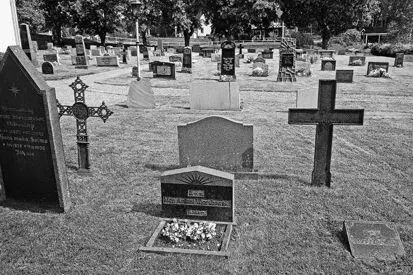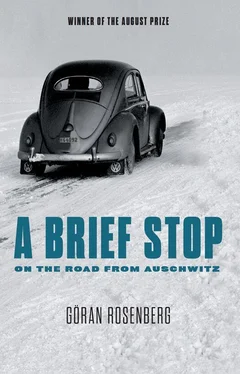Yes, as you can see, Tappudden-Furudal is also initially a camp for Norwegian refugees and part of a growing Norwegian-Swedish camp archipelago. As the winds of war change direction in 1943 and 1944, the camps are turned into bases for the training of Norwegian “police reserves.” The training is organized by the Norwegian exile government in London and carried out with the consent of the Swedish government, with the aim of creating military and police units that in the case of a German surrender shall be capable “of restoring Norwegian law and justice as soon as possible.”
The story of the Norwegian training camps on Swedish soil is a reasonably heroic one that many people will have good reason to remember, and memorials, to the extent that they’re erected on former camp sites, are dedicated to the Norwegians. Since 1994, the old ironworks in Furudal is home to a Norwegian veterans’ museum, and in Öreryd in the summer of 2008 a musical theater performance was put on to commemorate the years when the Norwegians came to town, and Elsa’s cafe was the center of world politics, and Sweden made some contribution to the right cause, after all. On a rough-hewn stone on the site of the former camp, a plaque reads “Öreryd refugee camp 1940–46,” and another conveys the gratitude of the Norwegians “for the good reception and kindness shown to us in the war years.”
Far fewer people remember the Poles. Actually, no one really remembers the Poles, still less the Polish Jews, who in fact do not officially exist, since they go by the name of Poles or Polish repatriandi . When the well-known Swedish journalist and writer Jan Olof Olsson (Jolo) happens to be passing through Öreryd in April 1972, he visits the churchyard by the white wooden church, where among the stones for departed shopkeepers, manufacturers, farmers, and stay-at-home daughters he finds two iron crosses engraved with clearly foreign names. “No dates; nothing more,” he notes. “Just these strange names in the Öreryd graveyard. The names are Polish. How did these two get here?”

The people with the Polish names get to Öreryd by train and bus in July and August 1945, after the Norwegian police reserves, just a day or so following the German surrender, have marched off “with flags flying and music playing” toward the railroad station in Hestra. Unlike the Norwegians, who are viewed by the locals as brothers or cousins of a sort, the people with the Polish names are viewed as foreigners first and foremost. Contacts between the villagers and the camp residents cool and drop off. The language barrier doesn’t help, and neither does the anxiety about — one might even say fear of — what the foreigners may bring with them. Pretty much everyone knows a bit about where they come from and what they’ve been through, and that presumably they’re all scarred in some way. Rumors of scuffles, fits of madness, and cases of suicide filter out into the little community around the white wooden church, and in any case the word is that the foreigners’ stay at the camp will be only a short one, because these are transit migrants or repatriandi who will soon be moving on to somewhere else.
So why make the effort?
Even those who make the effort don’t always have an easy time of it. On August 2, 1945, the Christian daily Svenska Morgonbladet publishes an article signed B.J. and titled “Our Guests from German Torture Camps”:
Brought together in camps of varying sizes surrounded by tall, barbed-wire fences, with only forestry workers’ primitive barracks or similar to live in, they are isolated from the outside world for week after week, month after month.… When the author of this piece tried to telephone one such camp in the Stockholm area … the female operator replied that the telephone number of the aliens’ camp “was unlisted.”…
These guests in our country, invited by the Red Cross, should have the right not to be seen as mere numbers in an impersonal mass of “ Lagerschwestern ” [camp sisters]. It is the isolation from “ordinary people” that really gets on their nerves.
Only the kindest of people should be allowed to have anything to do with these — often Jewish — victims of Nazism. One can hardly call the head of one such camp kind who when asked by a visiting member of the women’s corps if she could go and say hello to her friends, replied: “There is too much mollycoddling of these unpleasant refugees.” When she told him that she had got to know “these refugees” as charming and grateful, and that moreover one had to bear in mind that most of them had seen their parents and siblings consigned to the gas chambers of Auschwitz, he interrupted her curtly: “That has nothing to do with it.”…
We must remember that these are living people whom we have committed ourselves to rescuing, not a mere collection of numbers from miscellaneous clusters of German barracks.
On August 17, 1945, Svenska Dagbladet reports that forty “inmates” at Öreryd (“Polish camp in Småland”) panicked and set out on a march to Stockholm to protest against the camp conditions, and that the police stopped them at Mossebo, about five kilometers north of Öreryd, and that they were presently under arrest in Jönköping, awaiting further proceedings. “The forty who did not want to stay apparently fell prey to some kind of concentration camp psychosis. They are all very young, in the age range 16–20. They claim, among other things, that they did not receive sufficient allocations of food or tobacco in the camp.”
On August 29, 1945, the head of an unnamed aliens’ camp writes in the daily Göteborgs Handels- och Sjöfarts-Tidning ( GHT ) that the only “more general dissatisfaction” he has noted relates to food:
As a rule, this is because they are unused to Swedish food — they find black pudding and fish balls particularly hard to come to terms with, and most of them find it impossible to appreciate the Swedish habit of putting sugar in all kinds of dishes.
A more intractable problem is how to teach the refugees not to waste food; some kind of hoarding instinct seems to force them to store up supplies, which then go dry or moldy and eventually end up in the pig bucket.
The refugees’ unstable emotional state provides fertile soil for what might be termed camp psychoses, which take various forms. Sometimes it is individuals suddenly feeling themselves unjustly treated or persecuted by other camp residents, sometimes a general sense of alarm spreads rapidly, with anxieties about the future, the fate of relations.…
For the most part, however, the Swedish press doesn’t write very much about the aliens’ camps and the people who populate them. In community after community, Auschwitz temporarily moves in behind the local co-op store but leaves little trace in public life. Only rarely do journalists take the opportunity to visit the camps and interview the people who inhabit them and provide an account of their experiences and thereby also try to understand why some of them sometimes behave as they do. It’s as if a curtain of silence has descended between the world the visitors bring with them and the world that surrounds them. Or a curtain of anxiety, perhaps, that the two worlds will prove incompatible, or at least will not readily tolerate meeting each other. I note this anxiety also in Alva Myrdal’s otherwise enlightened view of the camps: anxiety that the darkness inside the residents will infect the enlightened society around them. “The victims of brutality themselves become brutalized,” she writes.
When life is reduced to its bare minimum, primitive selfishness is the only natural response.… Women whose reason should tell them that they will get enough food, and that there will be food for the next meal and for the next day too, cannot believe it because of their old terror. They save every crumb left over from the table. They pick dandelion shoots and other things to eat. They collect the pigs’ potato peelings. They rake up every dry little pea that has fallen on the ground. They even continue to steal from the camp stores.
Читать дальше













